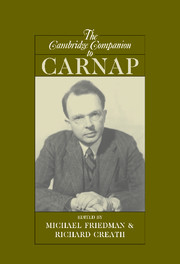Book contents
- Frontmatter
- Introduction: Carnap’s revolution in philosophy
- 1 Carnap’s intellectual development
- 2 Geometrical leitmotifs in Carnap’s early philosophy
- 3 Carnap and Frege
- 4 Carnap and Husserl
- 5 Carnap, Russell, and the external world
- 6 The Aufbau and the rejection of metaphysics
- 7 Carnap and the Vienna Circle: rational reconstructionism refined
- 8 Carnap and modern logic
- 9 Tolerance and logicism: logical syntax and the philosophy of mathematics
- 10 Carnap’s quest for analyticity: the Studies in Semantics
- 11 Carnap on the rational reconstruction of scientific theories
- 12 Carnap on probability and induction
- 13 Carnapian pragmatism
- 14 Quine’s challenge to Carnap
- Bibliography
- Index
10 - Carnap’s quest for analyticity: the Studies in Semantics
Published online by Cambridge University Press: 28 April 2008
- Frontmatter
- Introduction: Carnap’s revolution in philosophy
- 1 Carnap’s intellectual development
- 2 Geometrical leitmotifs in Carnap’s early philosophy
- 3 Carnap and Frege
- 4 Carnap and Husserl
- 5 Carnap, Russell, and the external world
- 6 The Aufbau and the rejection of metaphysics
- 7 Carnap and the Vienna Circle: rational reconstructionism refined
- 8 Carnap and modern logic
- 9 Tolerance and logicism: logical syntax and the philosophy of mathematics
- 10 Carnap’s quest for analyticity: the Studies in Semantics
- 11 Carnap on the rational reconstruction of scientific theories
- 12 Carnap on probability and induction
- 13 Carnapian pragmatism
- 14 Quine’s challenge to Carnap
- Bibliography
- Index
Summary
FROM SYNTAX TO SEMANTICS
Carnap's project to construct a comprehensive language of science, which occupied his attention from about 1935 to 1945, was centered on his search for a satisfactory definition of logical truth, or analyticity. The need for such a definition grew out of the logical syntax program he had first conceived in early 1931, which dropped the conception of meaning of Wittgenstein's Tractatus (1922) and instead applied the metalinguistic methods of Hilbert, Tarski, and Gödel to the scientific language as a whole.
Specifically, the need for a definition of analyticity had been precipitated by Gödel's Incompleteness Theorem, which had shown that there are apparently true sentences of arithmetic that are not logically provable, even given the axioms of arithmetic. Before this, the obvious criterion of logical and mathematical truth had always been provability, but Gödel had shown that this identification is unfounded and that logical and mathematical truth could not be understood as provability in a fixed axiom system. This not only threatened the logicist thesis of the logical character of all mathematical truth; it also called into question the fundamental tenet of logical empiricism that non-empirical (a priori) knowledge is analytic in the sense of being trivial and ultimately tautological. It was in this way, in fact, that the Vienna Circle developed a new “logical” brand of empiricism through a novel combination of two recent scientific advances: Wittgenstein’s notion of tautology and Frege–Russell logicism. This new doctrine solved empiricism’s traditional problem of the status of mathematics in a way that had not been conceivable before.
- Type
- Chapter
- Information
- The Cambridge Companion to Carnap , pp. 226 - 247Publisher: Cambridge University PressPrint publication year: 2007
- 7
- Cited by



